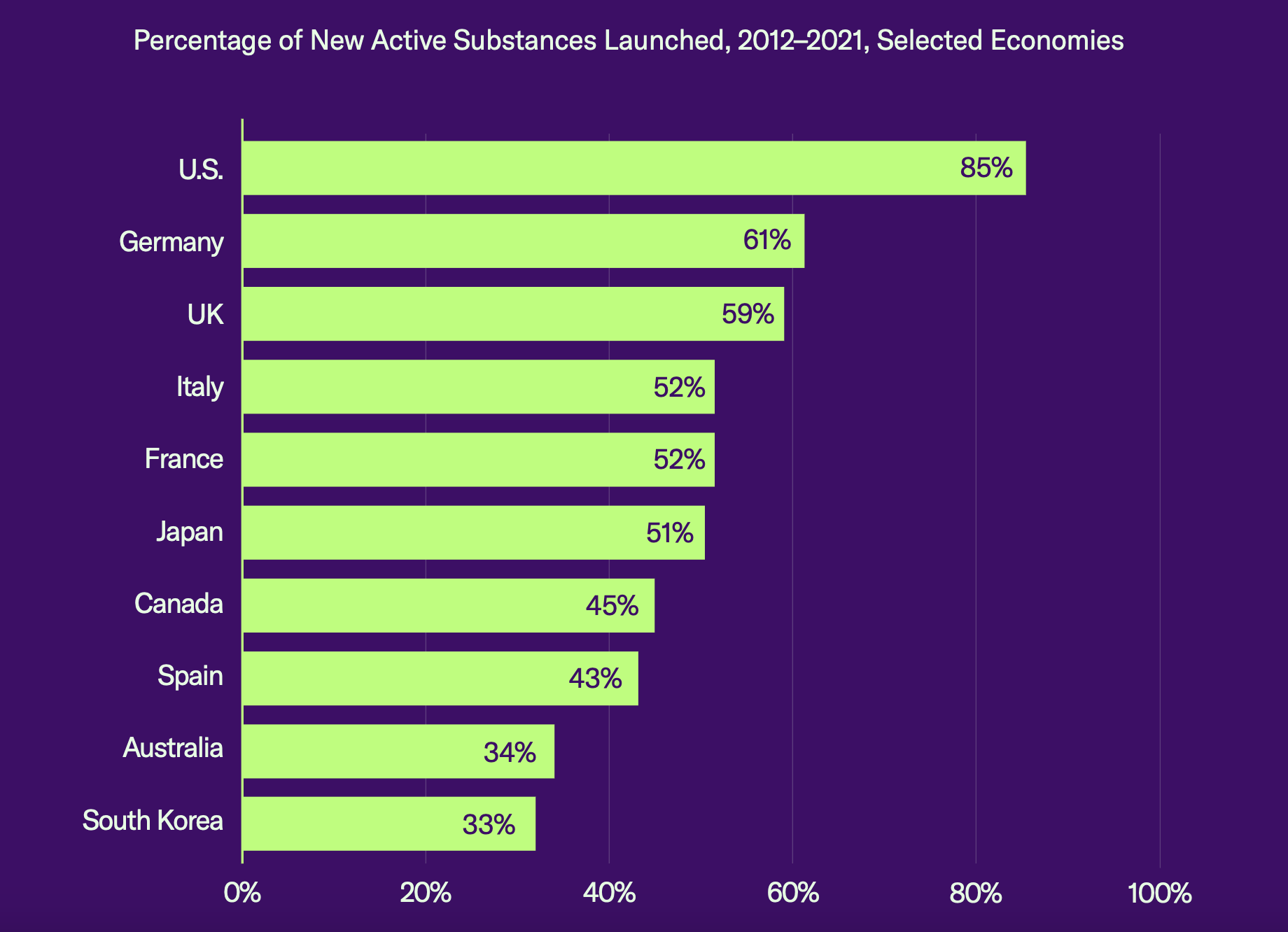[ad_1]
“All well being methods battle with rising prices; this isn’t a uniquely American phenomenon. Imposing a system of ‘take it or depart it’ value controls focusing on medicines will, inevitably, cut back affected person entry to new life sciences merchandise and applied sciences.” – GIPC report
At the moment, the U.S. Division of Well being and Human Companies (HHS) made its initial offers to pharmaceutical firms pursuant to the Biden Administration’s Inflation Reduction Act of 2022 (IRA), which permits the U.S. Authorities to “negotiate” Medicare drug costs below a set framework based mostly upon the period of time a drug has spent in the marketplace. Opponents of this system, together with the U.S. Chamber of Commerce, which is suing the government over the plan, argue it can’t be characterised as a voluntary negotiation for the reason that affected firms can be topic to onerous excise taxes for refusing to take part and since it could have devastating penalties for sufferers if firms had been to truly pull the affected medication. The quantities of right now’s preliminary gives weren’t revealed.
How the IRA Program Will Work
Prescription drug pricing controls are one facet of the IRA, a landmark piece of laws handed by Congress in August 2022 that additionally directs funding to be spent on clear vitality initiatives and elevated tax enforcement. The IRA authorizes the HHS Secretary to determine a Drug Worth Negotiation Program, codified at 42 U.S.C. § 1320f, to determine most truthful costs of sure medication that grow to be eligible for this system as a result of they represent a big portion of expenditures by Medicare Half B and Half D sufferers. Pharmaceutical firms that don’t comply with the worth set throughout negotiations with HHS must pay a brand new excise tax codified at 26 U.S.C. § 5000D, calculated based mostly on every day gross sales.
Finally yr’s IPWatchdog Life Sciences Masters program, Corey Salsberg, Vice President and World Head of IP Affairs for Novartis, used Novartis’ IRA-selected coronary heart failure drug, Entresto, to reveal how this is able to virtually impression firms. Salsberg defined that the excise tax – which begins at 187% of nationwide gross sales and goes to 1900% by some estimates – would imply a $45 billion wonderful within the first yr had been they to say no this system. “The one different method out of this entire factor is to tug all merchandise out of Medicare completely,” stated Salsberg, which might imply taking medication away from the tens of millions of Individuals on Medicare, “which in fact is completely unethical and infeasible,” he added.
However HHS Secretary Xavier Becerra said in the announcement today that this system is a “milestone on the march to make sure individuals with Medicare get truthful costs for prescribed drugs” and that he’s “assured that this course of will result in decrease costs, placing an finish to exorbitant value gouging by pharmaceutical firms.”
The Facilities for Medicare & Medicaid Companies (CMS) will proceed to barter with the collaborating drug firms by means of August 2024 and agreed upon costs will take impact in Medicare starting in 2026.
The Knowledge
Regardless of Becerra’s confidence that the IRA program may have constructive outcomes, the U.S. Chamber of Commerce’s World Innovation Coverage Heart (GIPC) launched a report yesterday, titled “The True Worth of Value Controls,” revealing information that exhibits affected person entry is negatively impacted by value controls.
The report in contrast market availability of latest medication throughout 10 key nations and located that the share of latest substances launched in america was 85%, whereas the runner-up, Germany, got here in at solely 61%. “Many new well being applied sciences and medicines are by no means launched in economies which have strict pricing and reimbursement controls in place,” stated the report.

Supply: GIPC report
The GIPC report additionally predicted that the variety of new merchandise launched post-IRA will probably be reduce by between 29% and 44% and that america will fall from the pinnacle to the center of the pack with regards to medical innovation and entry.
Another report published in July 2022 discovered that value controls have vital unfavorable results on affected person entry to new therapies as a result of they severely curtail funding for analysis and improvement. That report estimated that, with authorities value fixing, “solely 6 of 110 beforehand accredited therapies can be thought of ‘not in danger’ of being cancelled, or at very least divested.”
However HHS launched its own report together with right now’s announcement, citing information that exhibits U.S. costs throughout all medication (manufacturers and generics) in 2022 had been practically thrice as excessive as costs in 33 OECD comparability nations; that U.S. costs for model medication had been 422% of costs within the comparability nations; and that U.S. costs for unbranded generics had been decrease than costs as compared nations. The report additionally discovered that unbranded generics made up 90% of U.S. prescription quantity, in contrast with 41% of quantity within the different nations.
Courtroom Battle
The U.S. Chamber sued HHS in early June, elevating a number of constitutional and administrative legislation challenges to the implementation of the IRA’s drug pricing controls. The suit alleges that the IRA is actually disguising a compulsory value management regime as a negotiation course of that has no voluntary nature attributable to statutory difficulties for drug producers trying to go away the Medicare program, in addition to the exorbitant excise tax. Each the Chamber’s movement for preliminary injunction and the federal government’s movement to dismiss were denied in September 2023.
Neil Bradley, the Chamber’s Govt Vice President and Chief Coverage Officer, stated in response to the Administration’s announcement right now that “the true prices will probably be paid by American sufferers,” citing statistics from the GIPC report.
The report concluded by urging the U.S. authorities to “pause and contemplate the total ramifications of its pending coverage actions,” including:
“All well being methods battle with rising prices; this isn’t a uniquely American phenomenon. Imposing a system of ‘take it or depart it’ value controls focusing on medicines will, inevitably, cut back affected person entry to new life sciences merchandise and applied sciences. No matter the place the U.S. post-IRA expertise falls on the spectrum of that of different OECD economies, one plain conclusion is that the imposition of nationwide value and reimbursement controls invariably comes at a price: fewer new medicines and longer wait instances.”
The medication chosen for the worth negotiation program below the IRA are: Eliquis (Anticoagulant, Bristol-Myers Squibb); Jardiance (Diabetes, Lilly); Xarelto (blood thinner, Janssen); Januvia (diabetes, Merck); Farxiga (continual kidney illness, AstraZeneca); Entresto (coronary heart failure, Novartis); Enbrel (autoimmune illnesses, Amgen); Imbruvica (Leukemia, AbbVie/Johnson & Johnson); Stelara (Crohn’s illness and Ulcerative Colitis, Janssen); and Fiasp (insulin, Novo Nordisk).
Picture Supply: Deposit Photographs
Creator: robeo123
Picture ID: 1733104
[ad_2]
Source link

